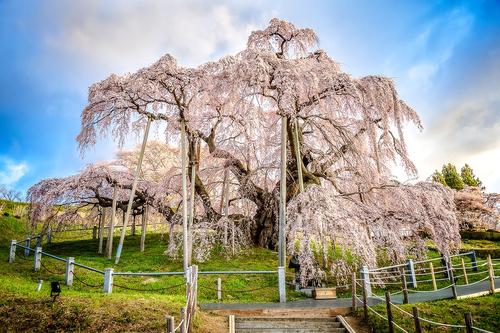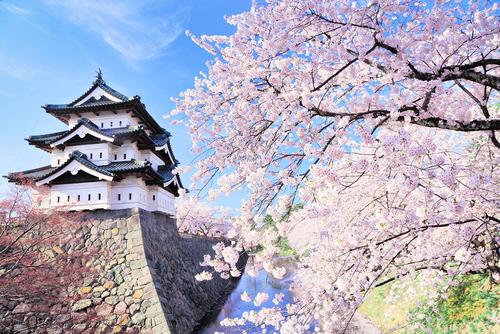What do cherry blossoms mean to the Japanese?

We will delve into what cherry blossoms mean to Japanese people and the relationship between Japanese people and cherry blossoms.
Since when have Japanese people loved cherry blossoms?
There are many records of the Japanese people's love of cherry blossoms, and as far back as the Kojiki, a goddess likened to a cherry blossom appears. The Manyoshu clearly depicts cherry blossoms as a "flower symbolizing spring," and we can see that a love for cherry blossoms had already taken shape in the hearts of the Japanese people by the Nara period, when the Manyoshu was compiled.
In the days when the lunar calendar was used, the start of a new year came with spring. Therefore, originally, cherry blossom viewing was about admiring plum blossoms, which bloom earlier than cherry blossoms. However, with the introduction of cherry blossoms from China, the custom gradually evolved into viewing cherry blossoms after the Heian period.
It is said that the first person to enjoy cherry blossom viewing was Emperor Saga, an emperor of the Heian period. The fact that cherry blossom viewing events hosted by the emperor began to be held annually is one of the reasons why the culture of cherry blossom viewing spread from the nobility to the common people.
Why Cherry Blossoms Are Special to Japanese People
Like cherry blossoms, there are other spring flowers that were introduced from China and established themselves in Japan. There are various theories as to why cherry blossoms alone became beloved throughout Japan, but the following reasons are generally thought to be the case.
・Appearance is cute and beautiful
One of the main reasons for this is that many Japanese people were simply captivated by the beauty of cherry blossoms, such as their thin, small petals and lovely pale pink color.
- Worship as a symbol of life and death
Cherry trees themselves have a long lifespan, with some varieties living for over 100 years, but cherry blossoms are extremely short-lived.They only bloom for a short period in the spring, and the thin petals scatter with the wind, so the best time to see them is less than half a month.
It is not difficult to imagine that when people in ancient times saw the beautiful cherry blossoms blooming for a moment and then quickly scattering, they reflected on their views of life and death and worshipped the cherry blossoms as something sacred and reminiscent of God.
・Looking forward to the flowering season
Even now, as the spring cherry blossom viewing season approaches, "cherry blossom forecasts" are reported across the country, and attention turns to when the cherry blossoms will be at their best.
Even in the days when weather forecasting was less advanced than it is today, when the cherry trees turned pink and flower buds began to form, many people would watch the cherry blossoms with anticipation, wondering when they would reach full bloom.
The transition from winter to spring signifies the beginning of farming and the end of the cold winter days, and it is thought that these expectations further enhanced the beauty of the cherry blossoms that herald the arrival of spring.
Japan's three great cherry blossoms

We will introduce three famous spots where you can enjoy Japan's "Three Great Cherry Blossoms." In addition to explaining the types and characteristics of cherry blossoms, we will also explain the highlights, so please use this as a reference when considering a cherry blossom viewing spot.
Why is it called one of the three great cherry blossoms?
There are many cherry blossom tree-lined streets and famous cherry blossom viewing spots in Japan, but among them, the "Miharu Takizakura" in Fukushima, the "Yamataka Jindaizakura" in Yamanashi, and the "Neodani Usuzumizakura" in Gifu are said to be the "Three Great Cherry Blossoms of Japan."
The Three Great Cherry Trees were selected from among the historic sites and scenic spots established during the Taisho era, and are also designated as natural monuments. They are famous for their long age, large size, and beautiful scenery.
In addition to the three major cherry blossoms, Shizuoka's Kariyado Shimoumazakura and Saitama's Ishido Kamazakura are also known as the "Five Great Cherry Blossoms," and all of these places are famous spots where you can enjoy magnificent cherry blossoms.
This time, we will introduce the three major cherry blossoms in more detail below.
Miharu Takizakura
Located in Tamura County, Fukushima Prefecture, Miharu Takizakura is a huge cherry tree said to be over 1,000 years old and is a Benishidarezakura variety. It stands over 13 meters tall, with branches stretching out over 10 meters in all directions. Famous as the oldest cherry tree in Japan, it is not only known for its size and longevity, but also for its stunning beauty.
The best time to see the cherry blossoms is from mid to late April, and during the season they are lit up at night, and there is also Sakura Park near the Miharu Takizakura where you can enjoy over 3,000 cherry trees, making it a famous spot where you can fully enjoy the cherry blossoms. There are various theories about the origin of the name "Miharu," including that it is "the three flowers of plum, peach, and cherry blossom blooming at the same time" or that it comes from "Oharu," but the name of the town is proof that the beauty of spring flowers has been a highlight since ancient times.
Location: Sakurakubo, Taki, Miharu Town, Tamura County, Fukushima Prefecture
Yamataka Jindai Cherry Blossoms
The Yamataka Jindai Sakura tree in Takekawa-cho, Hokuto City, Yamanashi Prefecture, is said to be the oldest of the three great cherry trees, being over 2,000 years old. The cherry tree is a type of "Edohiganzakura," and is the first designated national natural monument, as well as being one of the New 100 Famous Trees of Japan.
The Yamataka Jindai Sakura is said to be "the cherry tree planted by Yamato Takeru no Mikoto" due to its age, and has many other legends about it. It is over 10 meters tall, and its branches stretching out east and west for over 17 meters make for a spectacular sight. It is usually at its best around early April, when the surrounding area is filled with many cherry blossoms and daffodils, which are also in full bloom at the same time, creating a beautiful sight to enjoy.
Location: Yamataka, Takekawa-cho, Hokuto City
Neodani pale pink cherry blossoms
Located in Motosu City, Gifu Prefecture, the Neodani Usuzumi Sakura is a rare cherry tree whose blossoms change color from white to pink to pale ink depending on the season. The tree is estimated to be over 1,500 years old, and boasts height and branching that rivals the other three major cherry trees. The best time to see it is around early April, when the many Somei Yoshino cherry trees that bloom in Usuzumi Park, located near the Usuzumi Sakura, also bloom at the same time.
Address: Neoitasho Kamidan, Motosu City, Gifu Prefecture
summary

Since ancient times, Japanese people have been attracted to the beauty and grace of cherry blossoms, and have believed them to be the home of gods and spirits who herald the arrival of spring, and have also been subjects of reflection on life and death due to the fleeting nature of their lives.Among these, those with long ages and magnificent branches are especially treasured as the "Three Great Cherry Blossoms," and are protected by the government as natural monuments and historic sites of scenic beauty.
This article has been partially re-edited by KARUTA from an article originally published on "Nihongo Biyori."
Any unauthorized reproduction or use of the contents, text, images, illustrations, etc. of this website is strictly prohibited.
